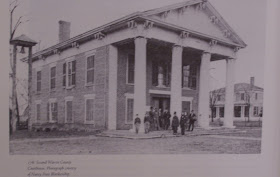Background: I
visited Warrenton, N.C., where my ancestral cousin, Lyndon M. Welborn, trained
for the Confederate army, to learn more about my family’s Civil War experience.
In Warrenton and in later research, I uncovered information about why men
fought for the Confederacy. Personal reasons varied, but slavery kept surfacing
as a main cause.
From my
book-in-progress, Dear Father I Am Sorry To Tell You (Copyright
B.J. Welborn; all rights reserved.):
 |
Richard Furman,
1755-1825,
was a prominent minister and president
of America's first Baptist convention.
Furman University in Greenville, S.C.,
took its name from him. |
When
South Carolina broke from the Union, delegates to the Secession Convention in
Charleston attached a “Declaration of the Immediate
Causes Which Induce and Justify the Secession of South Carolina from the
Federal Union” to its 1860 Ordinance of Secession. Three other states
also attached a list of reasons for secession to their ordinances: Georgia,
Mississippi and Texas.
South
Carolina’s declaration stated that a reason to dissolve its compact with the
Union was because non-slave holding states were violating a national agreement
(the retooled Fugitive Slave Act of 1850) to return runaway slaves. South Carolina secessionists
alleged northern states were violating the Fourth Amendment to the
Constitution. The Fourth Amendment stated “No person held to service or labor in one State, under the
laws thereof, escaping into another, shall, in consequence of any law or
regulation therein, be discharged from such service or labor, but shall be
delivered up, on claim of the party to whom such service or labor may be
due."
South
Carolina secessionists declared Northern states were “discharging from service”
fugitive slaves; Northerners harbored runaways and helped them flee to freedom.
South Carolina’s secession leaders, mostly members of the slave-owning planter
class, pointed out that South Carolina slave owners had been paying taxes on
their slave property, as required by the Union. Moreover,
South Carolina was exercising a Constitutional right by seceding. South Carolina was a good
Constitutional citizen.
Leading
South Carolinians equated Lincoln with abolitionism. They declared abolitionism a terrifying threat to
Southerners. Historian Walter
Edgar, citing historic newspaper reports in his book South Carolina, A History, writes of the Reverend Richard Furman of Greenville, S.C. Reverend Furman told
his congregation that Lincoln’s first election would mean “every negro in South
Carolina and every other Southern State will be his own master; nay, more than
that, will be the equal of every one of you.” Furman warned that abolitionist preachers would be willing
to marry “your daughters to black husbands.”
 |
| Warren County's second courthouse was standing when North Carolina troops gathered there for a festive send-off in 1861. The first structure burned down; this courthouse was built in the 1850s. |
North
Carolina did not elaborate its terse Ordinance of Secession.
North
Carolina’s African-American population today totals twenty-two percent, many
still living in the east, where flat sandy land had allowed profitable
plantations, in contrast to the state’s mountainous west. South Carolina today is more than
thirty percent black. The black
population lives mainly in the eastern “Lowcountry,” where huge plantations once
thrived. North Carolina’s black
population currently clusters in Warren County, now forty percent
African-American, and in five surrounding counties with populations more than
fifty percent black.
“I
guess many people living here now are descendants of the slaves who worked the
big plantations around here?” I asked Hunter as we walked to the library. Richard E. Hunter, Jr, Warren County's superior court clerk, reigned as keeper of Warrenton's historical flame.
“That’s
right,” he said. “The sandy soil around here made perfect growing conditions
for tobacco. And cotton.”
Hunter
was right about the library’s riches.
In a basement room dominated by a fine old conference table, I found
shelves of musty books on North Carolina history. I mined nuggets of
information about Lyndon and his regiment, as well as Lyndon’s three brothers
who fought in the Civil War. I
also found a long list of other ancestors who had fought, some who gave the
last full measure for The Cause.
Millions
of American families claim ancestors who fought in the Civil War, which took more
American lives than all other wars in our nation’s history combined, ten percent of the
nation’s population at the time.
Nearly 40 percent of Southerners claim ancestors who fought for the
Confederacy.
The
books in the basement didn’t reveal reasons my forebears became Confederate
fighters, but I am sure that when war erupted, ordinary men who were not
abolitionists joined Federal ranks to preserve the Union, and regular men
indifferent to slavery joined Confederate ranks, aiming to safeguard their way
of life.
Later,
I would learn that Lyndon volunteered for the Confederate army, against his
father’s wishes, because of a matter of the heart. (See Archives, March 15) His brothers fought because the
Confederacy drafted them. One brother, David, petitioned to avoid military
service, but that action ended in devastating defeat.
Coming soon:
The Story of David. See PREVIEWS
page.
